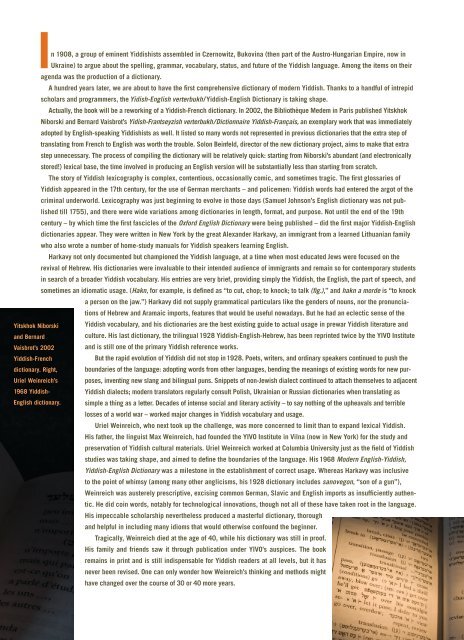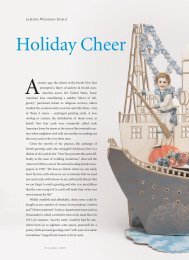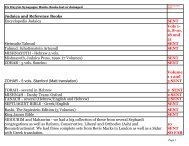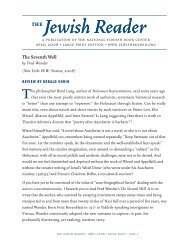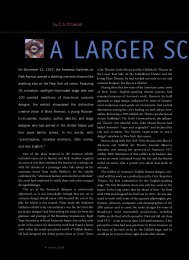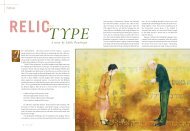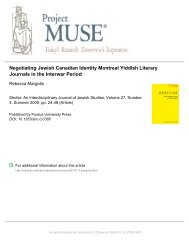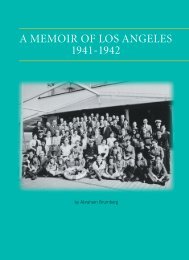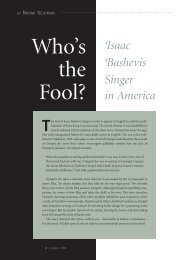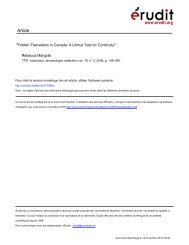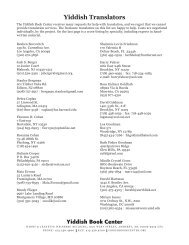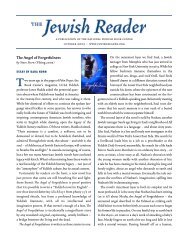by Catherine Madsen - Yiddish Book Center
by Catherine Madsen - Yiddish Book Center
by Catherine Madsen - Yiddish Book Center
You also want an ePaper? Increase the reach of your titles
YUMPU automatically turns print PDFs into web optimized ePapers that Google loves.
In 1908, a group of eminent <strong>Yiddish</strong>ists assembled in Czernowitz, Bukovina (then part of the Austro-Hungarian Empire, now in<br />
Ukraine) to argue about the spelling, grammar, vocabulary, status, and future of the <strong>Yiddish</strong> language. Among the items on their<br />
agenda was the production of a dictionary.<br />
A hundred years later, we are about to have the first comprehensive dictionary of modern <strong>Yiddish</strong>. Thanks to a handful of intrepid<br />
scholars and programmers, the Yidish-English verterbukh/<strong>Yiddish</strong>-English Dictionary is taking shape.<br />
Actually, the book will be a reworking of a <strong>Yiddish</strong>-French dictionary. In 2002, the Bibliothèque Medem in Paris published Yitskhok<br />
Niborski and Bernard Vaisbrot’s Yidish-Frantseyzish verterbukh/Dictionnaire <strong>Yiddish</strong>-Français, an exemplary work that was immediately<br />
adopted <strong>by</strong> English-speaking <strong>Yiddish</strong>ists as well. It listed so many words not represented in previous dictionaries that the extra step of<br />
translating from French to English was worth the trouble. Solon Beinfeld, director of the new dictionary project, aims to make that extra<br />
step unnecessary. The process of compiling the dictionary will be relatively quick: starting from Niborski’s abundant (and electronically<br />
stored!) lexical base, the time involved in producing an English version will be substantially less than starting from scratch.<br />
The story of <strong>Yiddish</strong> lexicography is complex, contentious, occasionally comic, and sometimes tragic. The first glossaries of<br />
<strong>Yiddish</strong> appeared in the 17th century, for the use of German merchants – and policemen: <strong>Yiddish</strong> words had entered the argot of the<br />
criminal underworld. Lexicography was just beginning to evolve in those days (Samuel Johnson’s English dictionary was not published<br />
till 1755), and there were wide variations among dictionaries in length, format, and purpose. Not until the end of the 19th<br />
century – <strong>by</strong> which time the first fascicles of the Oxford English Dictionary were being published – did the first major <strong>Yiddish</strong>-English<br />
dictionaries appear. They were written in New York <strong>by</strong> the great Alexander Harkavy, an immigrant from a learned Lithuanian family<br />
who also wrote a number of home-study manuals for <strong>Yiddish</strong> speakers learning English.<br />
Harkavy not only documented but championed the <strong>Yiddish</strong> language, at a time when most educated Jews were focused on the<br />
revival of Hebrew. His dictionaries were invaluable to their intended audience of immigrants and remain so for contemporary students<br />
in search of a broader <strong>Yiddish</strong> vocabulary. His entries are very brief, providing simply the <strong>Yiddish</strong>, the English, the part of speech, and<br />
sometimes an idiomatic usage. (Hakn, for example, is defined as “to cut, chop; to knock; to talk (fig.),” and hakn a morde is “to knock<br />
a person on the jaw.”) Harkavy did not supply grammatical particulars like the genders of nouns, nor the pronunciations<br />
of Hebrew and Aramaic imports, features that would be useful nowadays. But he had an eclectic sense of the<br />
Yitskhok Niborski <strong>Yiddish</strong> vocabulary, and his dictionaries are the best existing guide to actual usage in prewar <strong>Yiddish</strong> literature and<br />
and Bernard<br />
culture. His last dictionary, the trilingual 1928 <strong>Yiddish</strong>-English-Hebrew, has been reprinted twice <strong>by</strong> the YIVO Institute<br />
Vaisbrot’s 2002 and is still one of the primary <strong>Yiddish</strong> reference works.<br />
<strong>Yiddish</strong>-French<br />
But the rapid evolution of <strong>Yiddish</strong> did not stop in1928. Poets, writers, and ordinary speakers continued to push the<br />
dictionary. Right, boundaries of the language: adopting words from other languages, bending the meanings of existing words for new purposes,<br />
inventing new slang and bilingual puns. Snippets of non-Jewish dialect continued to attach themselves to adjacent<br />
Uriel Weinreich’s<br />
1968 <strong>Yiddish</strong>- <strong>Yiddish</strong> dialects; modern translators regularly consult Polish, Ukrainian or Russian dictionaries when translating as<br />
English dictionary. simple a thing as a letter. Decades of intense social and literary activity – to say nothing of the upheavals and terrible<br />
losses of a world war – worked major changes in <strong>Yiddish</strong> vocabulary and usage.<br />
Uriel Weinreich, who next took up the challenge, was more concerned to limit than to expand lexical <strong>Yiddish</strong>.<br />
His father, the linguist Max Weinreich, had founded the YIVO Institute in Vilna (now in New York) for the study and<br />
preservation of <strong>Yiddish</strong> cultural materials. Uriel Weinreich worked at Columbia University just as the field of <strong>Yiddish</strong><br />
studies was taking shape, and aimed to define the boundaries of the language. His 1968 Modern English-<strong>Yiddish</strong>,<br />
<strong>Yiddish</strong>-English Dictionary was a milestone in the establishment of correct usage. Whereas Harkavy was inclusive<br />
to the point of whimsy (among many other anglicisms, his 1928 dictionary includes sanovegon, “son of a gun”),<br />
Weinreich was austerely prescriptive, excising common German, Slavic and English imports as insufficiently authentic.<br />
He did coin words, notably for technological innovations, though not all of these have taken root in the language.<br />
His impeccable scholarship nevertheless produced a masterful dictionary, thorough<br />
and helpful in including many idioms that would otherwise confound the beginner.<br />
Tragically, Weinreich died at the age of 40, while his dictionary was still in proof.<br />
His family and friends saw it through publication under YIVO’s auspices. The book<br />
remains in print and is still indispensable for <strong>Yiddish</strong> readers at all levels, but it has<br />
never been revised. One can only wonder how Weinreich’s thinking and methods might<br />
have changed over the course of 30 or 40 more years.


